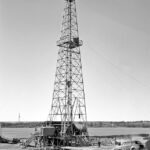The battery limit of a refinery or process plant refers to the physical boundary of the plant beyond which no process equipment or facilities are considered part of the plant. It is the point up to which the plant owner is responsible for the design, construction, and operation of the plant. It is the interface where the responsibility changes.
In other words, the battery limit defines the boundary where the plant owner’s responsibility ends and the responsibility of other entities begins. For example, the owner may be responsible for the operation of the plant up to the battery limit, but beyond that point, the responsibility for the transmission of the product may fall to a pipeline company.
The battery limit is typically defined in the project specifications and is an important consideration in the design and construction of the plant. The location of the battery limit can affect the cost, schedule, and feasibility of the project, as well as the regulatory requirements that apply to the plant.
Types of Battery Limits in a Refinery or Processing Plant | ISBL vs OSBL
There are two types of Battery limits in a refinery or process plant. They are called ISBL or Inside battery limit and OSBL or outside battery limit. Both ISBL and OSBL are common terms used in the design and operation of a refinery or process plant.
ISBL stands for Inside Battery Limits. It refers to the area within the physical boundary of the plant where the primary process equipment is located. The ISBL includes all process units, equipment, and facilities required for the production of the final product, such as reactors, distillation columns, pumps, and compressors.
OSBL stands for Outside Battery Limits. It refers to the area outside the physical boundary of the plant where the secondary process equipment and facilities are located. The OSBL includes all utility systems required for the operation of the plant, such as water treatment plants, power generation units, storage tanks, and loading facilities.
In other words, the ISBL is where the primary process takes place, while the OSBL is where the supporting facilities and equipment are located. The boundary between ISBL and OSBL is typically defined as the point where the process equipment connects to the utility systems, such as piping and electrical systems.
Both ISBL and OSBL are important considerations in the design and construction of a refinery or process plant, as they help define the scope of the project and the responsibilities of the plant owner and other entities involved in the operation of the plant.
Battery limits are clearly marked in the P&ID and Plot plans. For each unit, there will be separate battery limits. Refer to Fig. 1 (Image Reference: https://www.linkedin.com/pulse/what-battery-limit-refinery-nishit-kumar/) below which shows typical battery limits in a unit plant.

Importance of Battery Limit Concept
The battery limit is an important concept in the design, construction, and operation of a refinery or process plant for several reasons:
Defines the scope of the project: The battery limit defines the physical boundaries of the plant and the areas where the primary process equipment and supporting facilities are located. It helps to establish the scope of the project and provides clarity on the responsibilities of the plant owner and other entities involved in the operation of the plant.
Regulatory compliance: The battery limit can affect regulatory compliance requirements. Different regulatory agencies may have different requirements for the design, construction, and operation of a plant. Knowing the battery limit can help ensure that the plant owner is meeting all regulatory requirements and that the plant is being operated safely.
Cost estimation: The battery limit is a critical factor in estimating the cost of the plant. By knowing the battery limit, engineers can accurately estimate the cost of the process equipment, supporting facilities, and utility systems required for the operation of the plant.
Optimization of resources: The battery limit can help optimize the use of resources. By defining the boundaries of the plant, engineers can focus their efforts on the design and construction of the process equipment and supporting facilities within those boundaries, rather than extending those resources beyond the battery limit.
Maintenance: Battery limits help the maintenance team to isolate any unit at the battery limit and perform the required action.
Safety: During an emergency situation, hazardous and utility supplies can be stopped at the battery limit to prevent the further spread of the hazard to the remaining plant.
In summary, the battery limit is a crucial concept in the design and operation of a refinery or process plant as it helps to define the scope of the project, ensure regulatory compliance, estimate costs, and optimize the use of resources.
Deciding Battery Limit for a Refinery or Processing Plant
The decision on where to set the battery limit for a process plant or refinery involves a careful evaluation of several factors, including the following:
Process requirements: The battery limit should be defined based on the process requirements of the plant. This includes the type of raw materials used, the products produced, and the specific processing steps involved. The battery limit should encompass all process equipment and facilities necessary to meet these requirements.
Regulatory requirements: Regulatory requirements can influence the location of the battery limit. Certain regulatory agencies may have different requirements for the design, construction, and operation of different areas of the plant, which can affect where the battery limit is set.
Environmental considerations: The location of the battery limit can also be influenced by environmental considerations, such as the need to control emissions or the impact of the plant on the surrounding area.
Safety considerations: Safety considerations can also play a role in determining the location of the battery limit. The battery limit should be set in a way that minimizes the risk of accidents and ensures the safety of personnel and the surrounding community.
Cost considerations: The location of the battery limit can also impact the cost of the plant. The battery limit should be set in a way that optimizes the use of resources and minimizes costs without compromising safety or regulatory compliance.
Ultimately, the decision on where to set the battery limit for a process plant or refinery requires a careful evaluation of all these factors, as well as input from various stakeholders, including engineers, designers, regulators, and plant owners. The goal is to set the battery limit in a way that meets process requirements, ensures the safety and regulatory compliance, minimizes costs, and optimizes the use of resources.
Common Piping Considerations in Battery Limit
Some of the piping design concepts that are followed in battery limits are
- Battery limits are usually provided with lots of valves, spectacle blinds, drains, etc.
- In general, a three-way support restraint (Rest+Guide+Line Stop) is usually provided near the battery limit so that the maximum of the thermal movement is absorbed within the plant itself.
- An elevation difference is usually kept between pipes going from the battery limit of one unit to the other so that sufficient flexibility can be provided.







Great piece! Well done!
Is it required to indicate in the Plot Plan a Safety Radius (15M) from edge of the B/L platform to ensure that no Hazadous equipment will be installed within the safety radius?